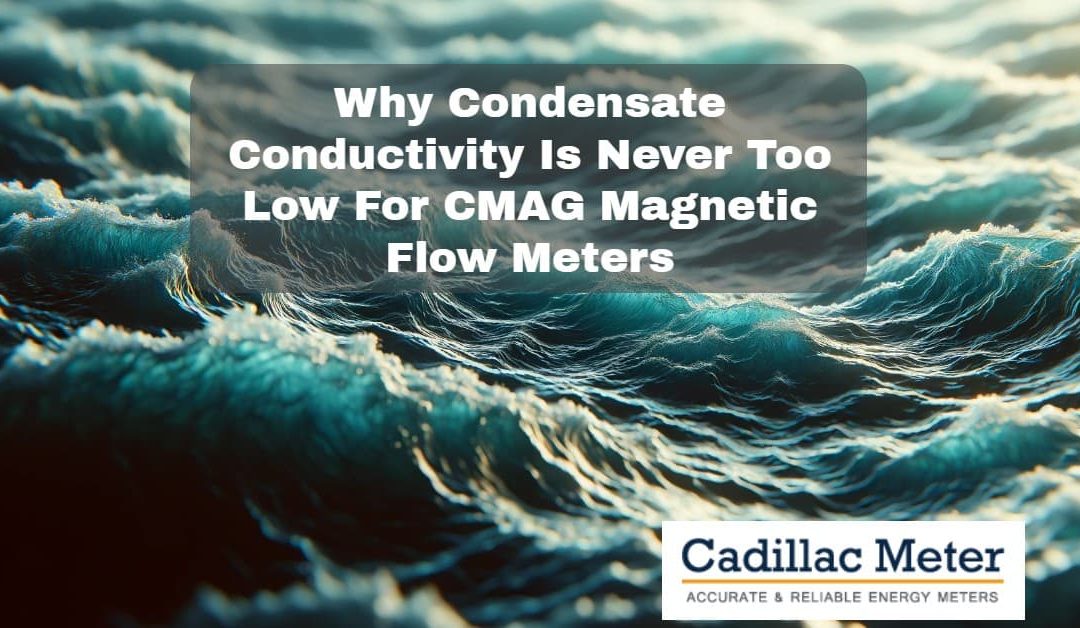Due to the nature of the magnetic flow meter measurement (which uses Faraday’s law to measure voltage/velocity of a liquid as it moves through a magnetic field generated by the coils embedded in the flow tube) there is a requirement for the liquid to maintain a certain level of conductivity in order to generate a voltage to measure. While this conductivity value varies by manufacture, it is usually between 3-10 uS/cm (except for a few that have much higher requirements).
As a general rule, the conductivity of the boiler feed water is very low (1.0-10.0 uS/cm) in most cases. However, outside of “closed loop” (not open or vented to atmosphere) high-pressure power generation applications, these steam systems are “open,” or in other words “vented,” to atmosphere. Most of the venting occurs at the heat exchange interface, and downstream when the steam has condensed to liquid. Introducing atmosphere and especially oxygen to the system makes the water become very aggressive. It instantly attacks the piping wall, leaching minerals from the pipe and even from the atmospheric gases themselves. In turn, this takes a pure condensate with relatively low conductivity (1.0-5.0 uS/cm) at the condensation point and instantly increases the ionic contamination, thus, increasing the conductivity.
For example, a 10 uS/cm conductivity standard is used for calibration, which is typically packaged in small plastic bottles with an air tight seal. If you open a bottle and insert a conductivity cell that has been calibrated, you can watch as it climbs from 10 uS/cm and easily reaches 12-15 uS/cm in a minute or two. This is strictly a function of the low ionic strength solution absorbing particulate from the atmosphere that is introduced when the cap is removed. Now, if you take that same scenario and add metal piping systems, this jump in conductivity is even more severe, easily reaching the 10-15 uS/cm range shortly after condensing.
In addition, magnetic flow meters will operate at the actual or uncompensated conductivity value. Water has a relationship with temperature called the “salt curves”, which define the water’s conductivity as a function of temperature. This relationship is stated as a 2-5%* conductivity increase for every 1°C temperature increase. Since conductivity for water, as with most liquids, is significantly effected by temperature, when measuring conductivity it is usually done in conjunction with a temperature measurement and referenced back (using the salt curves) to a fixed temperature point (25°C or 77°F).
This means that if you had a condensate application where the conductivity was measured very low at 2.0 uS/cm (compensated) using a conductivity analyzer, and the process or condensate was at 85°C or 185°F, the (uncompensated) value the magnetic flow meter sees is (85°C-25°C) = 60°C x 0.035 = 2.1 uS/cm + 2 uS/cm = 4.1 uS/cm.
Combining these two factors (open system + uncompensated conductivity), it is extremely unlikely that any condensate in a typical heating system will be below the operating conductivity value of the CMAG (3.0 uS/cm) threshold. This is why over the last 12 years— and over 1000 installations of our CMAG meter— we have never had a condensate application where the CMAG did not operate due to low conductivity.
* The lower the conductivity value the higher the % change with temperature. The lower value achievable with water is 0.54 uS/cm. So, at 1.0 uS/cm you are in the 4-5%/°C part of the curve. Above 50 uS/cm the relationship becomes linear at 2%/°C.



